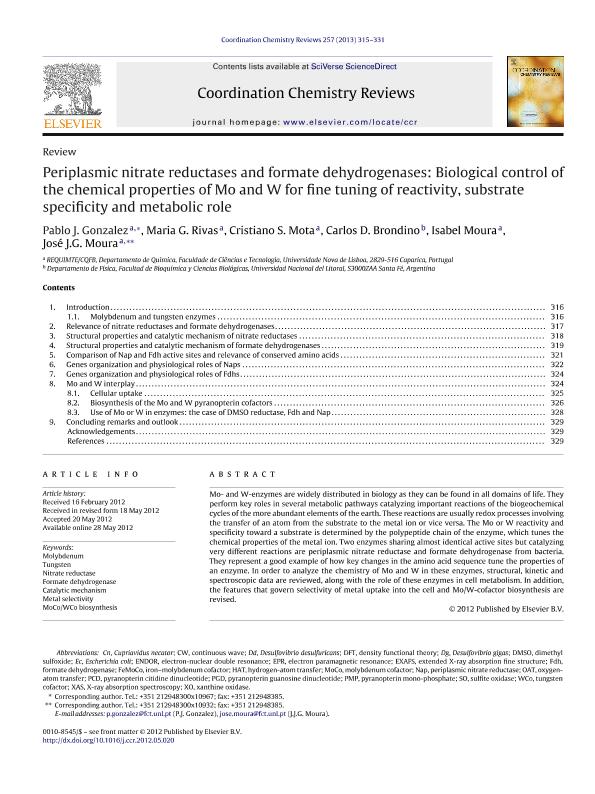Artículo
Periplasmic nitrate reductases and formate dehydrogenases: control of the chemical properties of Mo and W for fine tuning of reactivity and substrate specificity and metabolic role
González, Pablo Javier ; Rivas, Maria Gabriela
; Rivas, Maria Gabriela ; Mota, Cristiano S.; Brondino, Carlos Dante
; Mota, Cristiano S.; Brondino, Carlos Dante ; Moura, Isabel; Moura, José J.G.
; Moura, Isabel; Moura, José J.G.
 ; Rivas, Maria Gabriela
; Rivas, Maria Gabriela ; Mota, Cristiano S.; Brondino, Carlos Dante
; Mota, Cristiano S.; Brondino, Carlos Dante ; Moura, Isabel; Moura, José J.G.
; Moura, Isabel; Moura, José J.G.
Fecha de publicación:
01/2013
Editorial:
Elsevier
Revista:
Coordination Chemistry Reviews
ISSN:
0010-8545
Idioma:
Inglés
Tipo de recurso:
Artículo publicado
Clasificación temática:
Resumen
Mo- and W-enzymes are widely distributed in biology as they can be found in all domains of life. They perform key roles in several metabolic pathways catalyzing important reactions of the biogeochemical cycles of the more abundant elements of the earth. These reactions are usually redox processes involving the transfer of an atom from the substrate to the metal ion or vice versa. The Mo or W reactivity and specificity toward a substrate is determined by the polypeptide chain of the enzyme, which tunes the chemical properties of the metal ion. Two enzymes sharing almost identical active sites but catalyzing very different reactions are periplasmic nitrate reductase and formate dehydrogenase from bacteria. They represent a good example of how key changes in the amino acid sequence tune the properties of an enzyme. In order to analyze the chemistry of Mo and W in these enzymes, structural, kinetic and spectroscopic data are reviewed, along with the role of these enzymes in cell metabolism. In addition, the features that govern selectivity of metal uptake into the cell and Mo/W-cofactor biosynthesis are revised.
Archivos asociados
Licencia
Identificadores
Colecciones
Articulos(CCT - SANTA FE)
Articulos de CTRO.CIENTIFICO TECNOL.CONICET - SANTA FE
Articulos de CTRO.CIENTIFICO TECNOL.CONICET - SANTA FE
Citación
González, Pablo Javier; Rivas, Maria Gabriela; Mota, Cristiano S.; Brondino, Carlos Dante; Moura, Isabel; et al.; Periplasmic nitrate reductases and formate dehydrogenases: control of the chemical properties of Mo and W for fine tuning of reactivity and substrate specificity and metabolic role; Elsevier; Coordination Chemistry Reviews; 257; 2; 1-2013; 315-331
Compartir



